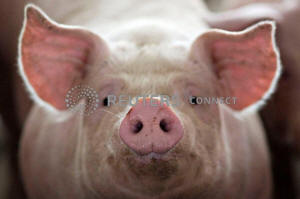|
Yale study revives cellular activity in
pig brains hours after death
 Send a link to a friend
Send a link to a friend
 [April 18, 2019]
By Steve Gorman [April 18, 2019]
By Steve Gorman
(Reuters) - Yale University scientists have
succeeded in restoring basic cellular activity in pigs' brains hours
after their deaths in a finding that may one day lead to advances in
treating human stroke and brain injuries, researchers reported on
Wednesday.
The scientists emphasized that their work did not even come close to
reawakening consciousness in the disembodied pig brains. In fact the
experiment was specifically designed to avoid such an outcome, however
improbable.
Still, the study raises a host of bioethical issues, including questions
about the very definition of brain death and potential consequences for
protocols related to organ donation.
The research grew out of efforts to enhance the study of brain
development, disorders and evolution. The main practical application is
the prospect of allowing scientists to analyze whole brain specimens of
large mammals in three dimensions, rather than through studies confined
to small tissue samples, Yale said.

The study, backed by the National Institutes of Health, offers no
immediate clinical breakthrough for humans, according to the authors.
Results of the experiment, to be published on Thursday in the journal
Nature, run contrary to long-accepted principles of brain death, which
hold that vital cellular activity ceases irreversibly seconds or minutes
after oxygen and blood flow are cut off.
The limited rejuvenation of circulatory function and cellular metabolism
in pig brains, which were harvested from animals slaughtered at a
meat-packing plant, was achieved four hours after death by infusing the
brains with a special chemical solution designed to preserve the tissue.
"The intact brain of a large mammal retains a previously
underappreciated capacity for restoration of circulation and certain
molecular and cellular activities multiple hours after circulatory
arrest," lead researcher Nenad Sestan said in a Yale press release
issued ahead of the study.
It was in the lab run by Sestan, a Yale professor of neuroscience,
comparative medicine, genetics and psychiatry, that researchers
developed the so-called BrainEx system used to pump artificial nutrients
into the pig brains' vascular network.
[to top of second column]
|

A pig, nearing market weight, stands in a pen at Duncan Farms in
Polo, Illinois, U.S. April 9, 2018. Picture taken April 9, 2018.
REUTERS/Daniel Acker

'NOT A LIVING BRAIN'
Scientists stressed, however, that the treated brains still lacked
any detectable signs of organized electrical activity associated
with perception, awareness or consciousness.
"Clinically defined, this is not a living brain, but it is a
cellularly active brain," study co-author Zvonimir Vrselja,
associate researcher in neuroscience.
The BrainEx preservative included substances to block nerve signals.
Researchers also were ready to halt any electrical activity that
might have emerged through anesthetics and temperature reduction,
according to Yale.
While the study offers no immediate therapeutic benefits for humans,
it creates a new research platform that may ultimately help doctors
find ways to revive brain function in stroke patients or to test new
treatments for restoring brain cells damaged by injury, the authors
said.
In the meantime, the research could spark new quandaries surrounding
the determination of death itself, widely defined by one measure as
the irreversible loss of all brain function. The blurring of that
line has implications in turn for deciding when doctors are
ethically bound to go from preserving a patient's life to preserving
their organs.
"For most of human history, death was very simple," Christof Koch,
president and chief scientist of the Allen Institute for Brain
Science in Seattle, said in a Nature article accompanying
publication of the Yale study.
(Reporting by Steve Gorman in Los Angeles; Editing by Bill Tarrant
and Sandra Maler)
[© 2019 Thomson Reuters. All rights
reserved.]
Copyright 2019 Reuters. All rights reserved. This material may not be published,
broadcast, rewritten or redistributed.
Thompson Reuters is solely responsible for this content.
 |